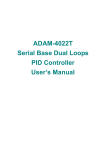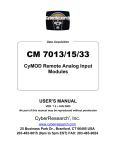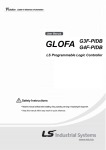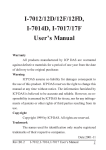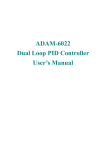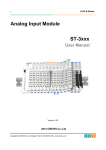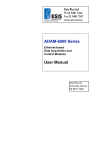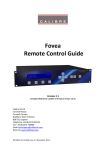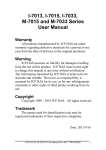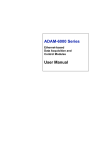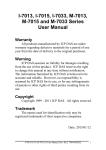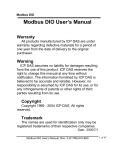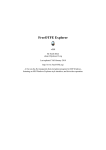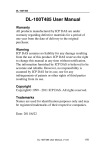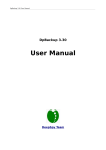Download ADAM-4022T Serial Base Dual Loops PID Controller User`s Manual
Transcript
ADAM-4022T Serial Base Dual Loops PID Controller User’s Manual Warning Message : The ADAM-4022T is recommended to be used in general purposed air conditioning application. When using this product in applications that required particular safety or when using this product in important facility, pay attention to the safety of the overall system and equipment. For example, install fail-safe mechanism, carry out redundancy checks and periodic inspections, and adopt other appropriate safety measures as required. ADAM-4022T dual loop PID Controller Introduction Function The ADAM-4022T dual loop PID controller is a Serial-based controller. It was designed as the product of Advantech’s ADAM-4000 series with Serial based PID controller With an excellent accuracy ±0.15%, the ADAM-4022T is an ideal controller for temperature and other process variable in heating and cooling application, test and environmental work. Easy to operate ADAM-4022T utility software can help you to select input and range configuration, set the operating parameter (SP, Sv, Pv ….. etc) for your process control needed. ADAM-4022T utility software also integrates the trend chart to help you to monitor and debug your control setting. Industrial Design ADAM-4022T was designed to use in industrial environment. It can be installed in standard DIN rail inside the cabinet. And it can be powered by unregulated 10~30Vdc to meet the various power supplied source in field. It also withstands ambient temperature up to 60 o C and resists the effects of vibration and mechanical shock. Wiring & Installation The ADAM-4022T is a Dual loop PID controller. There are three analog input, one analog output, one digital input and one digital out put for each loop usage. The analog input channels is 16-bit, universal signal accepted design. It provides programmable input ranges on all channels. It accepts various analog inputs +/-10V, 0~20mA and 4~20mA. The analog output channel is 12 bit with 0~10V, 0~20mA and 4~20mA acceptable input type. Each analog channel is allowed to configure an individual range for several applications. The digital input can be configured as the emergency shutdown trigger input and the digital output is designed as the common alarm output. The PID loop function can be disabled by ADAM-4022T utility software tool, that is, ADAM-4022T can be a pure universal I/O module after disabling the PID loop function. ADAM-4022T Fig. 7-1 ADAM-4022T Drawing Application Wiring Fig. 7-2 Analog Input/Output Wiring Diagram Fig. 7-3 Digital Input/Output Wiring Diagram Jumper Setting P0 AI0 P1 AI0 P0 AI1 P1 AI1 P1 AO0 P0 AO0 Initial Switch JP1 JP2 JP3 JP4 JP5,JP6 JP7,JP8 Loop 1 AI Channel 0 Loop 1 AI Channel 1 Loop 0 AI Channel 0 Loop 0 AI Channel 1 Loop 0 AO Channel 0 Loop 1 AO Channel 0 I: Current Signal V: Voltage Signal Input Default: V Output default: I Note: When using RTD or Thermistor, please set the jumper to voltage signal setting. Initial Switch Setting You can set the initial mode by switching the switch to INIT, after setting your ADAM-4022T, you can switch to NORMAL mode. Operation Interface Open the ADAM 4000 Utility Software, the software tool will auto-scan the ADAM 4000 module through the network. Clicking the “4022T” in the system tree of left dialog block, User can select “Modbus” or “BACnet” as supported Protocol Clicking the “4022T” in the system tree of left dialog block to go to ADAM-4022T configuration page. In this page, user can configure the input channel, output channel and PID loop function. And ADAM-4022T support two communication protocol – Modbus/RTU and BACnet MS/TP. User can select the supported protocol in this page. Input Channel Configuration Page : In ADAM-4022T input channel configuration page, user can enable the input channel, select the input signal type and select the DI status. Channel 0, 1 is the analog input as the control parameter for PID loop 0 and channel 2, 3 is for PID loop 1 when the PID loop function is enabled. ADAM-4022T also support MODBUS/RTU protocol, user can see the detail MODBUS address register number for each channel in this page. It can be a very important reference for communication work. Input Channel Config. Page Input Signal Type Select MODBUS Register Address Calibration ADAM-4022T input channel configuration also support Zero and Span calibration function. Clicking the “Zero Calib” and “Span Calib” bottom to go to the calibration dialog block, user can set the initial zero value and span range then click the “Execute” bottom to proceed the channel calibration work. Please refer the following pictures for operation guideline. Output Channel Configuration Page : For output channel configuration, there are two analog output channel in ADAM-4022T. The output channel 0 is used as the control output for PID loop 0 and channel 1 is for PID loop 1 when PID loop function is enabled. The configuration for output channel is quite similar as input configuration. User can easily to finish the configuration with the friendly operating interface of ADAM-4022T utility software. Channel Calibration Output Signal Type Select Analog Manual Output Setting ADAM-4022T can be a pure universal I/O module when PID being set in Free mode. User can use “Data Area” to setup the analog output to send a specific value for such kind application. This function can also be controlled with MODBUS/TCP protocol through Ethernet network for HMI/SCADA application. For calibrating the analog output channel, user can use external certificated signal measured device as calibrator then use the “Trim for 4mA” and “Trim for 20mA” calibrating function to fine tuning the channel output signal for calibration requirement. PID Loop Configuration ADAM-4022T is designed as a stand alone PID controller. We offer a very convenient software tool for user to configure the PID controlled parameter. In this configuration page, there is a real time trend chart to show the values changing of SV, PV and MV. It is very helpful for user to monitor and diagnose the PID control situation. For the functionality of the bottom in PID configuration page, please refer the explanation of the following table. Bottom Function PID loop number Control Mode Selection : Free : Stop PID Control Auto : PID Loop Automatically Manual : Manual Control Parameter Setting and Monitoring SV : Setpoint Value PV : Process Value MV : Controlled Output Value PV, MV Alarm Status PID Setting Button (go to PID setting page) PID Tuning Button (go to PID tuning page) After finishing the setup work in configuration page, please click the setting bottom to go to the detail parameter setting screen. PV/SV Setting : Button Function PID Algorithm: Standard: Standard PID calculation. DIFF First: Differentiation as first priority. SV Range High SV Range Low PV Range High SV high limit value SV low limit value PV high limit value PV Range Low PV low limit value Low Pass Filter set value Low Pass Filter Calculation : MV Feedback = Reading MV x Filter Value + Previous MV x (1Filter Value) PID loop sensing time interval SV & PV High High alarm setpoint SV & PV High alarm setpoint SV & PV Low Low alarm setpoint SV & PV Low alarm setpoint Low Pass Filter Interval (msec) Alarm H-High Alarm High Alarm Low Alarm L-Low MV Setting Button Function PID Action: Control Action Mode Setting Direct: Direct (Heating) Action, The "MV" decreases when the "PV" increases. Reverse: Reverse (Cooling) Action, The "MV" increases when the "PV" increases. Range High MV/FB high limit value Range Low MV/FB low limit value Filter set value Filter (0.0~1.0) MV Init. Value MV Output High MV Output Low MV E-Stop Value Setting MV initial value MV output high limit MV output low limit Setting MV frozen value while PID being emerged shutdown For PID parameter tuning, please refer the PID tuning page. In this page, the P, I, D parameters can be adjusted to achieve the optimal control result. The real time trend chart provides a powerful tool for user to supervise the parameters adjustment result. Appendix A ASC II Command Set Command Description % AANNTTCCFF Sets the address, input mode, baud rate, checksum status (NN: new address TT: always 00 CC: baudrate FF: bit6=1 checksum enable bit6=1 checksum disable) $AAB Read channel diagnostic $AAF $AAM $AA0 $AA1 $AA2 $AA2Ci $AA2Cihhh $AA3Ci $ AA3Cihhh $AA5vv $AA6 $AA7 Remarks !NN: OK ?AA: error !AAmmmm: OK (m: 0 normal 1 over highest value 2 over lowest value 3 invalid calibration) ?AA: error Return the firmware version code !AAAv.vv: OK from the specified module. ?AA: error Return the module name from the !AA4022T: OK specified module ?AA: error Calibrate the analog input module to !AA: OK correct the gain error ?AA: error Calibrate the analog input module to !AA: OK correct the offset error ?AA: error Returns the configuration !AA00CCFF: OK parameters. ?AA: error Read the MAX calibration value for !AACihhh: OK analog output ?AA: error (i: channel 0~1) Calibrate the analog output to !AA: OK correct the MAX value ?AA: error (i: channel 0~1 hhh: 12bits raw data) Read the MIN calibration value for !AACihhh: OK analog output ?AA: error (i: channel 0~1) Calibrate the analog output to !AA: OK correct the MIN value ?AA: error (i: channel 0~1 hhh: 12bits raw data) Enable/Disable multiplexing !Aa: OK (vv: 00~0F) ?Aa: error Asks a specified input module to !AAvv: OK return the status of all AI channels ?AA: error Asks a specified module to return !AAooii: OK the status of all DI/DO channels ?AA: error Command $AA7CiRrr $AA8Ci $AA9Ci $AA9CiRrr #AA Description Set the channel input range code (i: channel 0~3 rr: range code) Read the channel input range code (i: channel 0~3) Read the channel output range code (i: channel 0~1) Set the channel output range code. After setting, the output will be set to minimum value. (i: channel 0~1 rr: range code) Return the input values from all channels of the specified analog input module Remarks !AA: OK ?AA: error !AACiRrr: OK ?AA: error !AACiRrr: OK ?AA: error !AA: OK ?AA: error >+xx.xxx+xx.xxx+xx.xxx+xx.x xx: OK (format: V, mA is xx.xxx; RTD, Thermistor is xxx.xx) ?AA: error #AAi Return the input value from the >+xx.xxx: OK specified channel in the analog input ?AA: error module (i: channel 0~3) #AAccdd Set a single or all digital output >: OK channels. ?AA: error (cc: 00 all channel, dd: 00~03 10 channel 0, dd:00~01 11 channel 1, dd:00~01) #AACidd.ddd Analog output to the specified >: OK channel ?AA: error (i: channel 0~1 dd.ddd: engineering units) #AAO Read all AO channel value >+xx.xxx+xx.xxx: OK ?AA: error #AAOi Read AO value from an output >: OK channel ?AA: error (i: channel 0~1) #AAPRsscc Read PID value >aaaaaaaabbbbbbbb…: OK (ss: starting index, 00h~FFh each value use 8 HEX to cc: total tot read, MAX is 40h) indicate a long value ?AA: error #AAPWssvvvvvvvv Set PID value >: OK (ss: index, 00h~FFh ?AA: error vvvvvvvv: the long value) Appendix B Channel Specification Analog input channel Channel index in command 0 1 2 3 Channel index in hardware LOOP0 Ain0 LOOP0 Ain1 LOOP1 Ain0 LOOP1 Ain1 Input range code mapping and input calibration value Range Range value Span calibration Zero calibration code 0x07 4~20 mA 20.0 mA 0.0 mA 0x08 0~10 V 10 V 0V 0x0D 0~20 mA 20.0 mA 0.0 mA 0x20 PT-100 (-100~100oC) 140 ohms 60 ohms a=0.00385 0x21 PT-100 (0~100 oC) 140 ohms 60 ohms a=0.00385 0x22 PT-100 (0~200 oC) 180 ohms 60 ohms a=0.00385 0x23 PT-100 (0~600 oC) 400 ohms 60 ohms a=0.00385 0x24 PT-100 (-100~100 oC) 140 ohms 60 ohms a=0.00392 0x25 PT-100 (0~100 oC) 140 ohms 60 ohms a=0.00392 0x26 PT-100 (0~200 oC) 180 ohms 60 ohms a=0.00392 0x27 PT-100 (0~600 oC) 400 ohms 60 ohms a=0.00392 0x2A PT-1000 (-40~160 oC) 1600 ohms 850 ohms 0x30 Thermistor 3K (0~100 oC) 10 K ohms 200 ohms o 0x31 Thermistor 10K (0~100 C) 30 K ohms 800 ohms Output range code mapping Range code 0x00 0x01 0x02 Range value 0 ~ 20 mA 4 ~ 20 mA 0 ~ 10 V Default setting Convert rate: 60 Hz Range code: 0x08 (10 V) Automatic ADC convert: false Channel mask: 0x0F Auxiliary ADC: temperature sensor Appendix C PID Parameters Table: Modbus Modbus Register Register Loop 0 Read/ Decimal Write Place Code Loop 1 Descriptions Enable/Disable PID loop function 0:Open mode -- no PID control, 41000 41256 Open/Close Mode Read / Write 0 ADAM-4022T will be a pure I/O module 1:Close mode – enable PID loop function 2:Manual mode – manual control analog output PID Mode Selection 41002 41258 PID Mode Read / Write 0 0:Standard PID Calculation Mode 1:Differential First Mode 41008 41264 Process value bare data Read Only 3 PV value。 41012 41268 Manipulator value bare data Read Only 3 MV value 41016 41272 DI On/Off Read Only 0 DI for Emergency Shutdown 41018 41274 DO On/Off Read Only 0 Alarm DO On 41020 41276 Set point Value Read / Write 3 SV (Set point Value) 41024 41280 Read / Write 3 Read / Write 3 3 (Range high) Read / Write MV & FB RH (Range low) Read / Write 3 PV engineering data Read Only 3 PV RH (Range high) PV RL 41026 41282 (Range low) MV RH 41032 41034 41036 41288 41290 41292 PV Source Engineering Value Range high (PV RH must > PV RL) PV Source Engineering Value Range low (PV RL must < PV RH) MV Engineering Value Range high MV RH must > MV RL MV Engineering Value Range high MV RL must < MV RL PV Source engineering data MV engineering data 41040 41296 MV engineering Read / data Write 3 MV engineering data can not only be automatically created by PID loop, but it also can be manual setup when PID loop set in “manual” mode. It will be translated as MV bare data AO output。 MV RL<MV engineering data<MV RH Modbus Modbus Register Register Read/ Decimal Write Place Code Descriptions Loop 0 Loop 1 41044 41300 PID PV value Read Only 3 PID PV value 41046 41302 PID SV value Read Only 3 PID SV value 41048 41304 PV Filter value Read / Write 3 1st order filter value for PV source 0<(PV Filter value/1000)<1.0 0: 0 ~ 10V 1: 0 - 20mA 2: 4 - 20mA 3: PT-100 (385) –100~100’C 4: PT-100 (385) 0~100’C 5: PT-100 (385) 0~200’C 41054 41310 PV Range Read Only 6: PT-100 (385) 0~600’C 0 7: PT-100 (392) –100~100’C 8: PT-100 (392) 0~100’C 9: PT-100 (392) 0~200’C 10: PT-100 (392) 0~600’C 11: PT-1000 –40~160’C 12: Thermistor 3K 0~100’C 13: Thermistor 10K 0~100’C 0: 0 ~ 10V、 1: 0 - 20mA、 2: 4 - 20mA 41060 41316 MV Range Read Only 0 41062 41318 PID KP Read / Write 3 Read / Write 3 Read / Write 3 41064 41066 41320 41322 PID KI PID KD PID Proportional factor for PV Source PID KP=(Input value/1000) PID Integrated factor for PV Source PID KI=(Input value/1000) PID Differential factor for PV Source PID KD=(Input value/1000) 41074 41330 PID KP (PID) Read Only 3 PID Proportional factor for PID calculation 41076 41332 PID KI (PID) Read Only 3 PID Integrated factor for PID calculation 41078 41334 PID KD (PID) Read Only 3 PID Differential factor for PID calculation Modbus Modbus Register Register Loop 0 Read/ Decimal Write Place Code Loop 1 Descriptions <=0 : Loop empty 41336 Control loop period setting (msec) for PV Read / Write 41084 41340 Control loop period setting (msec)for PID Read Only 0 >0 : Loop controlling 41086 41342 Count down value of control loop period Read Only 0 counting value<=0 then calculating PID loop 41088 41344 Previous Loop Open/Close status Read Only 0 Record the previous Loop Open or Close mode for Loop Initial set。 41090 41346 NSEC Read Only 0 Calculating the newest Loop interval as nsec 41092 41348 OLD NSEC Read Only 0 Calculating the previous Loop interval as old nsec 41080 0 >0 : Loop controlling <=0 : Loop empty 0: maintaining the previous MV output keep PID open 1: setting the previous MV output as 41094 41350 Power recovery Read / action setting Write 0 initial value and keeping PID Close 2: PID open, using MV initial value as MV output 41096 41352 MV Initial Value Read / Write 3 MV initial value for power recovery action 41098 41354 Last DI State Read Only 0 Previous Scan DI State (reference for control program) 41100 41356 Last DO State Read Only 0 Previous Scan DO State (reference for control program) 41102 41358 PV Alarm HH limit Read / Write 3 PV Alarm H limit Read / Write 3 PV Alarm LL limit Read / Write 3 41104 41106 41360 41362 PV Alarm High High Limit Value (<PV RH) PV Alarm High Limit Value (<PV RH & PV Alarm HH) PV Alarm Low Low Limit Value (>PV RL) Modbus Modbus Register Register Loop 0 Loop 1 41108 41364 41110 41366 Read/ Decimal Write Place Read / Write 3 PV Alarm Dead Read / Band % Write 3 Code PV Alarm L limit Descriptions PV Alarm Low Limit Value (>PV RL & PV Alarm LL) PV Dead band % 0<(Input Value/1000)%<10 % PV Alarm Status 41112 41368 PV Alarm Status Read Only 0 41138 41394 MV Output High Read / Limit Write 3 MV Output Low Read / Limit Write 3 41140 41396 MV Output High Limit (<MV RH) MV Output Low Limit (>MV RL) MV Output Alarm Status 41142 41398 MV Output Alarm Status Read Only 0 41144 41400 MV Emergency Read / Value Write 3 41146 41402 PV open wire flag Read Only 0 PID Direct/Reverse Read / Write 0 41150 41406 0:Normal、1:HH、2:H、3:L、4:LL。 0:Normal、1:H、2:L MV output value while emergency shutdown DI being active 0:Normal 1:Open wire 0:Direct Mode 1:Reverse Mode 41152 41408 SV High Limit Read/ Write 3 SV High Limit value 41154 41410 SV Low Limit Read / Write 3 SV Low Limit value MODBUS functions address mapping (1) Coils Address Mapping Table Index(Address) Remarks 1(0) DI 0 status 2(1) DI 1 status 3~16(2)~(15) Reserved (for those reserved area, there will be no effect if you set it) 17(16) DO 0 status 18(17) DO 1 status 19~128(18)~(127) Reserved (2) Registers Address Mapping Table Index(Address) 1(0) 2(1) 3(2) 4(3) 5~10(4)~(9) 11(10) 12(11) 13~20(12)~(19) 21(20) 22(21) 23(22) 24(23) 25~200(24)~(199) 201(200) 202(201) 203(202) 204(203) 205(204) 206(205) 207~210(206)~(209) 211~212(210)~(211) 213~214(212)~(213) 221(220) 1000~1511 (999)~(1510) --- Remarks P0Ain0 value P0Ain1 value P1Ain0 value P1Ain1 value Reserved AO 0 value AO 1 value Reserved P0Ain0 status (0: normal; 1: over high; 2: over low; 3: invalid calibration) P0Ain1 status P1Ain0 status P1Ain1 status Reserved P0Ain0 range code P0Ain1 range code P1Ain0 range code P1Ain1 range code AO 0 range code AO 1 range code Reserved Module name Version AI channel enable PID data area (total 512 registers) Each PID data formed by two registers, for example: PID data[0] = reg[1000]*65535+reg[1001] PID loop-0 occupies from PID data[0] to PID [127]. PID loop-1 occupies from PID data[128] to PID [255]. For function 0x03, 0x04, you can read 100 registers at most one time For function 0x10, you must set even number of registers at a time. The starting address must be an even number as well. You can only set at most 100 registers at a time. Not support Appendix D BACnet objects supported Object type Analog Input Analog Output Analog Value Binary Input Binary Output Device Loop Multi-state Input Multi-state Output Instance 0 1 2 3 0 1 0 1 2 3 0 1 0 1 11 0 1 0 1 2 3 0 1 Remarks Refer to the P0Ain0 Refer to the P0Ain1 Refer to the P1Ain0 Refer to the P1Ain01 Refer to the AO0 Refer to the AO1 Refer to the PID SV of Loop 0 Refer to the PID MV of Loop 0 Refer to the PID SV of Loop 0 Refer to the PID MV of Loop 1 Refer to the DI 0 Refer to the DI 1 Refer to the DO 0 Refer to the DO 1 “11” is the default object instance PID loop 0 PID loop 1 Refer to the PV alarm in PID loop 0 Refer to the MV alarm in PID loop 0 Refer to the PV alarm in PID loop 1 Refer to the MV alarm in PID loop 1 Refer to the Control Mode in PID loop 0 Refer to the Control Mode in PID loop 1



























